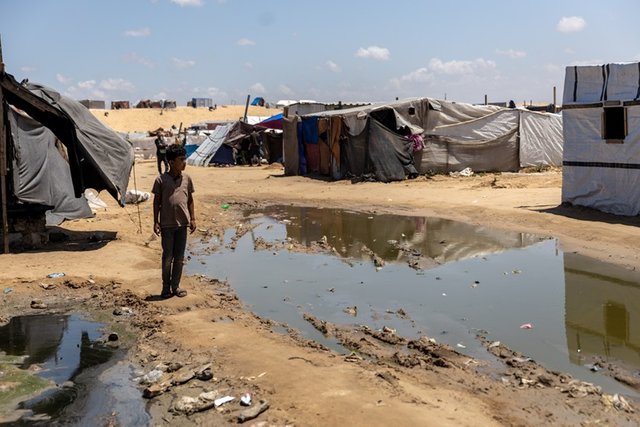Israel’s military claims it hit a Hezbollah ‘weapons warehouse’ but Lebanese Health Ministry says residence attacked.

Two rounds of a polio vaccination campaign are expected to be launched at the end of August and September 2024 across the Gaza Strip to prevent the spread of circulating variant type 2 poliovirus (cVDPV2).
WHO and UNICEF request all parties to the conflict to implement humanitarian pauses in the Gaza Strip for seven days to allow for two rounds of vaccination campaigns to take place. These pauses in fighting would allow children and families to safely reach health facilities and community outreach workers to get to children who cannot access health facilities for polio vaccination. Without the humanitarian pauses, the delivery of the campaign will not be possible.
During each round of the campaign, the Palestinian Ministry of Health (MoH), in collaboration with the World Health Organization (WHO), the United Nations Children’s Fund (UNICEF), the United Nations Relief and Works Agency for Palestine Refugees (UNRWA) and partners, will provide two drops of novel oral polio vaccine type 2 (nOPV2) to more than 640 000 children under ten years of age.
The poliovirus was detected in July 2024 in environmental samples from Khan Younis and Deir al-Balah. Worryingly, three children presenting with suspected acute flaccid paralysis (AFP), a common symptom of polio, have since been reported in the Gaza Strip. Their stool samples have been sent for testing to the Jordan National Polio Laboratory.
Over 1.6 million doses of nOPV2, which is used to stop cVDPV2 transmission, will be delivered to the Gaza Strip. The deliveries of the vaccines and the cold chain equipment are expected to transit through Ben Gurion Airport before arriving in the Gaza Strip by the end of August. It is essential that the transport of the vaccines and cold chain is facilitated at every step of the journey to ensure their timely reception, clearance and ultimately delivery in time for the campaign.
Detailed plans to support vaccinators and social mobilizers to reach eligible children across the Gaza Strip have been finalized. Vaccination will be administered by 708 teams, including at hospitals, field hospitals, and primary health care centres in each municipality of the Gaza Strip. Around 2700 health workers, including mobile teams and community outreach workers, will support the delivery of both rounds of the campaign. This will be supported by awareness-raising efforts to mitigate the risks of polio infection.
At least 95 per cent vaccination coverage during each round of the campaign is needed to prevent the spread of polio and reduce the risk of its re-emergence, given the severely disrupted health, water and sanitation systems in the Gaza Strip.
Other requirements for successful campaign delivery include sufficient cash, fuel and functional telecommunication networks to reach communities with information about the campaign.
Further efforts are underway to strengthen and expand poliovirus surveillance and routine immunization.
The Gaza Strip has been polio-free for the last 25 years. Its reemergence, which the humanitarian community has warned about for the last ten months, represents yet another threat to the children in the Gaza Strip and neighboring countries. A ceasefire is the only way to ensure public health security in the Gaza Strip and the region.
Notes for editors
=>On 16 July 2024, wastewater test results confirmed that cVDPV2 was detected in six samples collected on 23 June 2024 from Khan Younis and Deir al Balah ES sites in the Gaza Strip. Further sequencing analysis confirmed that these cVDPV2 isolates are linked to a variant poliovirus strain last detected in Egypt in 2023.
=>The Gaza Strip had a high level of vaccination coverage across the population before the escalation of hostilities in October 2023. However, due to the impact of the conflict, routine immunization coverage (for the second dose of inactivated polio vaccine) dropped from 99 per cent in 2022 to less than 90 per cent in the first quarter of 2024, increasing the risk of vaccine-preventable diseases to children, including polio.
=>The risk of cVDPV2 spread, within the Gaza Strip and internationally, remains high given gaps in children's immunity due to disruptions in routine vaccination, decimation of the health system, constant population displacement, malnutrition and severely damaged water and sanitation systems. The situation has also increased the risk of the spread of other vaccine-preventable diseases such as measles as well as cases of diarrhoea, acute respiratory infections, hepatitis A and skin diseases among children.